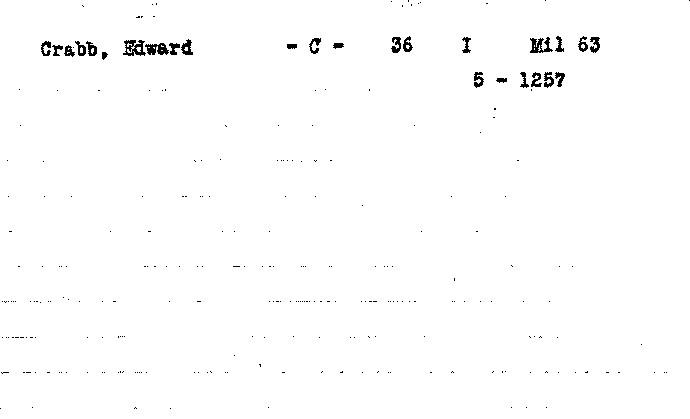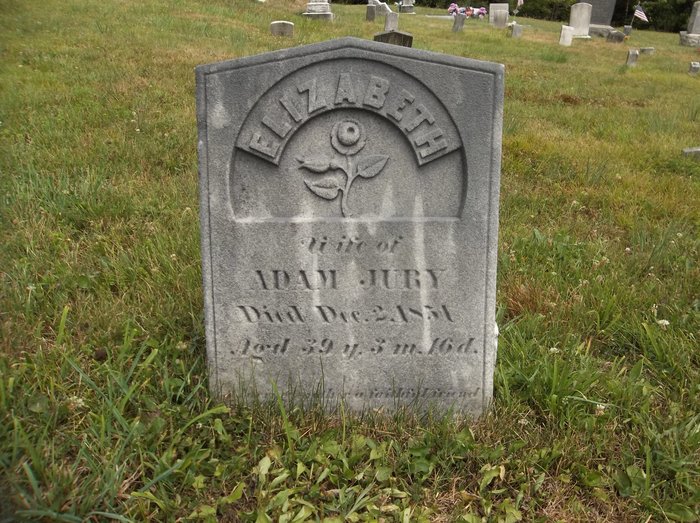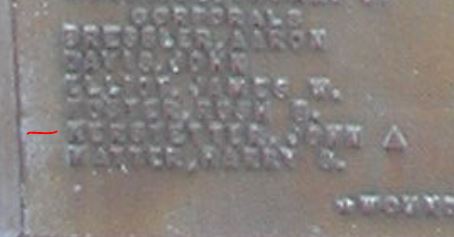Posted By Norman Gasbarro on July 1, 2016

Another Memorial Day has gone by and the grave of Edward Crabb, an African American Civil War soldier buried in Gratz Union Cemetery, continues to be un-decorated [no G.A.R.-Star-Flag-Holder and Flag]. In addition to being un-decorated, the Crabb family plot is one of the worst maintained in a cemetery which is known for its manicured grave sites and magnificent views of the Mahantongo Mountains to the north. In the family plot photograph above, taken on Memorial Day 2016, two of the stones are broken and one is tipped so that it can not be easily read. The broken stone at the left is for Lydian [Schoffstall] Crabb, later Witman, who was married to Henry Crabb (1817-1856), brother of Edward Crabb, and was the mother of a Civil War soldier, William P. Crabb.
The stone at the right, shown below in detail (also taken on Memorial Day 2016), is for Civil War soldier Edward Crabb.
These broken stones have been evident for many years. Could it be that these grave sites were desecrated by vandals who knew that this was an African American burial plot?
It is not surprising that this has happened in a community that for at least the last 20 years has had a bigot as the chief interpreter of its history. The disgraceful result of the promotion of her erroneous view that Blacks never lived in Gratz, is that a native of Gratz, a veteran, who happened to be African American, lies unrecognized, except for a damaged stone, near the front of the only cemetery in town!
Following a history of the honorable record of this Civil War veteran, a remedy will be proposed – which will include proper recognition of Edward Crabb at his gravesite in Gratz – and the removal of the bigots who are illegally operating the Gratz Historical Society.

Edward Crabb was born on 12 November 1832 in Gratz. He was the son of Peter Crabb (1787-1860), an African American who was one of the first settlers in Gratz shortly after the town was laid out by Simon Gratz in the early part of the 19th Century. The descendants of Peter Crabb were numerous. By the time of the Civil War, Gratz had one of the highest populations of free Blacks in the Lykens Valley area. Some of the sons and daughters of Peter Crabb married into the White families of the area, but others chose to marry into the numerous other African American families in a broader region – to Line Mountain in the north and to Peter’s Mountain in the south – a large triangular area which represents the geographical reach of this Civil War Research Project. Most of the descendants who married White ended up passing, while those who married Black were usually unable to do so. Edward Crabb was one of those who married Black and did not pass.
William P. Crabb, the Civil War soldier mentioned in the first paragraph of this blog post, was previously profiled in in a blog post here on 15 May 2015. The conclusion of that post was that although he was the grandson of Peter Crabb, the African American pioneer settler of Gratz, because his mother was White and he was light-skinned enough to pass, he and his descendants chose to refer to themselves as White. William died in 1917 and is buried at the Maple Grove Cemetery in Elizabethville.
In 1850, Edward Crabb, a laborer, is found in the household of Samuel Umholtz, a farmer of Lykens Township. In that census, he was listed as mulatto.
By 1863, Edward had learned the craft of shoemaking and registered twice for the Civil War draft – once in Coal Township, Northumberland County, and once in Lykens Township, Dauphin County. In both cases, he was listed as colored.

A few days after the draft registration, Edward Crabb was in Harrisburg with his company and regiment, ready to serve for the Emergency of 1863, Lee’s invasion of Pennsylvania. The 36th Pennsylvania Infantry Militia, Company C, was composed primarily of men from Lykens Township and Gratz and served from 4 July 1863 through 11 August 1863. Prior to the Civil War, both Edward Crabb and his brother John Peter Crabb were listed among the members of the Gratztown Militia, a home guard unit that was organized under the Second Amendment to the U.S. Constitution. It was this Gratztown Militia that became Company C. Edward and his brother John Peter were the only known African Americans in the company that consisted of about 76 men. It is important to note here that these emergency forces were under Pennsylvania command, not Federal command and therefore there were no racial restrictions on the service of African Americans. Most of the men knew each other from their “home guard” militia service and no evidence has been seen to suggest that there was any discrimination against the brothers who served in Company C. Note: The Pennsylvania Veterans’ File Card, shown above, is from the Pennsylvania Archives.
The brief history of this militia regiment in the war is recorded in Bates, Volume 5, page 1257, Pennsylvania’s official Civil War history, and therein is included the name of Edward Crabb. The responsibilities of the 36th Pennsylvania Infantry Militia included the cleaning up of the Gettysburg Battlefield, which was hazardous due to the large number of decomposing bodies that needed to be properly buried as well as the un-exploded shells remaining there. Bates reports specifically on the activity of the 36th Pennsylvania Infantry Militia beginning on page 1228 of Volume 5:
So rapid were the movements of the armies, and so soon after call for the militia was made the decisive battle fought, that the men had scarcely arrived in camp [at Harrisburg], and been organized, before the danger was past….
The militia was, however, held for some time after this, and was employed on various duty. The Thirty-Sixth Regiment was sent to Gettysburg, and its commanding officer, Colonel H. C. Alleman, was made Military Governor of the district, embracing the battle-ground. It was engaged in gathering in the wounded and stragglers from both armies, in collecting the debris from the field and sending away the wounded as fast as their condition would permit. Colonel Alleman, in his official report, gives the following schedule of property as having been collected from the battle-field: “Twenty-six thousand six hundred and sixty-four muskets, nine thousand two hundred and fifty bayonets, one thousand five hundred cartridge boxes, two hundred and four sabres, fourteen thousand rounds of small-arm ammunition, twenty-six artillery wheels, seven hundred and two blankets, forty wagon loads of clothing, sixty saddles, sixty bridles, five wagons, five hundred and ten horses and mules, and six wagon loads of knapsacks and haversacks.” The ordinance stores he shipped to the Washington Arsenal, and the remainder of the government property he turned over to an agent of the War Department. From the various camps and hospitals on the battle-field, and in the surrounding country, he reports having collected and sent away to northern cities, “twelve thousand and sixty-one wounded Union soldiers, six thousand one hundred and ninety-seven wounded rebels, three thousand and six rebel prisoners and one thousand six hundred and thirty-seven stragglers….”
Following the Civil War, Edward Crabb returned to Gratz where he married Catherine “Rossie” Jones and began raising a family. Rossie was a descendant of another of the many African American families of the Lykens Valley area. Their first son, William Morris Crabb, was born in Gratz on 8 December 1866. His death certificate, 30 December 1934, shown below, confirms his birthplace as Gratz, his race as Negro, and the names of his parents as Edward Crabb and Rossie Jones.

Click on document to enlarge.
In the Census of 1870, the family appears in Gratz. Edward is a shoemaker and his race is mulatto.
In the Census of 1880, the family is in Hubley Township, Schuylkill County, where Edward was then working as a coal miner. His race was given as Black. It is not known at this time when the Edward Crabb family moved from Gratz to Hubley Township or why they moved. In the post-Civil War years attitudes of the dominant population of Whites toward Blacks began to change in the Lykens Valley area and gradually, those Black families who had pioneered in the region, began to disappear, or if they were able to pass, some chose to remain. Thus today, there are descendants of the pioneer Peter Crabb still living in the Lykens Valley, but all as White. The erroneous view that African Americans never lived in Gratz could not have developed until after the last African Americans lived there – perhaps some time just after Edward Crabb moved to Hubley Township in the 1870s.
Following his death on 26 October 1886 in Hubley Township, Edward Crabb was buried in Gratz Union Cemetery (also known as Simeon’s Cemetery). Two of his children are also buried in the same plot. There is no evidence to suggest that he was ever recognized at his grave site as a Civil War veteran – by the G.A.R. (which in Gratz did not permit Blacks as members), by the American Legion, or by the current V.F.W. More research must be done to determine when this racial discrimination first occurred and who was involved in promoting it.
So, the question now is, “Why isn’t Edward Crabb recognized as a Civil War soldier?” He is recognized by the Commonwealth of Pennsylvania as such. He also is recognized as such in the “official” history of Gratz, page 341, which was published in 1997. However, that Gratz history does not mention any race or national origin for the the Crabb family.
It can now be stated unequivocally that Edward Crabb is not recognized because he was an African American. There has been a deliberate effort on the part of one person at the Gratz Historical Society, Lois Schoffstall, to hide and erase the fact that some of the earliest settlers of Gratz were African Americans and their sons and grandsons served honorably in the Civil War. While Lois Schoffstall, who has only lived in Gratz for about forty years, cannot be credited with originating the erroneous idea that the Gratz area only ever had White people as residents, she must be blamed for perpetuating it. In the opinion of some in the area, she is the chief interpreter of local history. But, the views she is promoting are racist and dangerous and a close examination of them reveals that she is anything but credible.
When this Civil War Research Project began [in 2009], a specific statement was made by Lois Schoffstall that it was not to be reported by the Project that the Crabb family was African American. This led to the initial dispute between the Project and Lois Schoffstall which eventually erupted into the separation of the Project from the Society and the exposure by the Project of the then-discovered [2013] illegal activities at the Society conducted by Lois Schoffstall and her husband Charles Schoffstall. The revealing of how the Schoffstall’s illegally seized control of the Society and its assets can be found in two prior posts on this blog. See: (1) The Illegal Takeover of the Gratz Historical Society, and (2) “Cooking the Books” at the Gratz Historical Society. Those posts showed how the Schoffstall’s have been using the Gratz Historical Society for their own bigoted and financial purposes for the past 20 years. Now, there is at least $30,000 missing from an endowment fund set up to perpetuate the Society. This fact is denied by Charles Schoffstall, but is proven by the annual financial statements that he has himself issued and signed. In addition, over the past 20 years, Charles Schoffstall has failed to collect and submit State Sales Tax on thousands of dollars of consumer transactions, has claimed that the Society is a 501(c)3 organization when it is not, has falsified annual financial statements which grossly underestimate the worth of the Society, and has presented falsified information to the Gratz Bank in order to maintain his personal control of the Society accounts. All the while, the Society has not paid property and school taxes on two commercial real properties it owns. It is also appalling that in the most recent annual financial statement of January 2016, the net worth of the Society is only given at about $141,000, when it it believed by many area residents that when all assets are accounted for, the net worth should be well over $500,000. Where are the missing assets, why aren’t they accounted for in the official records, and why is no one concerned?
Despite the fact that the illegal takeover and the financial falsifications have been known in the Gratz community for almost three years, the Schoffstall’s remain in complete control of the Society and there does not appear to be any effort by anyone to remove them. As recently as as this current week, the personal phone number of the Schoffstall’s was given in the local newspapers as the official phone number of the Gratz Historical Society. Thus, there is no hesitancy to publish it here – (717) 365-3342. Lois Schoffstall should be called and asked why she refuses to state that African Americans were among the pioneer settlers of Gratz. But more importantly, for the purposes of the recognition of a native of Gratz who served honorably in the Civil War, why Edward Crabb‘s grave in Gratz goes un-decorated each Memorial Day, 4th of July, and Veterans’ Day. Lois Schoffstall also should be asked whether the “shrine” to the Ku Klux Klan that she personally approved continues to be part of the Society museum and whether the offensive video which depicts a “Heil Hitler” salute to the Ku Klux Klan “shrine”, which she also approved, is still being sold. See: Why Are There Ku Klux Klan Uniforms in Gratz?
The Schoffstall’s are not the persons who, going forward, should correct this problem. They should be removed from their control of the Gratz Historical Society, whether by the Society members or the law or both, and held accountable for what they have done – including re-payment of all missing money. And, anyone who has supported them actively or by allowing their names to be used as members of a sham Board of Directors should also be held accountable. Any further activities of the Gratz Historical Society conducted by the Schoffstall’s – from the date of this blog post- will be questioned as to why the Schoffstall’s are allowed to continue to represent themselves as officials of the Society and who has allowed them to do so. This includes the use of any town facilities, including the Gratz Community Center, which they have scheduled for a program on Thursday evening, 7 July 2016.
Members of the Society and residents of the Lykens Valley area should stop supporting these bigots and their white supremacist interpretations of local history. And, an effort should be made by decent members of the Gratz community to correct and repair the damage the Schoffstall’s have done – including giving proper recognition to the only known African American Civil War soldier buried in the Gratz Union Cemetery. This includes the repair or replacement of his grave marker and that of his sister-in-law, who was the mother of a Civil War soldier. But at this point, only a public act of reconciliation, including an apology to the extended family of this veteran, will suffice.
Constructive comments will be accepted by either adding them to this blog post or by sending them via e-mail to the Project.
Note: Previously, the brother of Edward Crabb, John Peter Crabb, has been the subject of many posts here on this blog – including his service in the U.S. Colored Troops, his helping to charter a Colored G.A.R. Post in Harrisburg, and his role as a political and Civil Rights leader in the post-war years in Harrisburg. He also has been recognized by at least one author who studied the Civil War pension system and how African American soldiers were able to become part of it. Like his brother Edward, John Peter Crabb was born in Gratz, and while he also served in the 36th Pennsylvania Infantry Militia, his longest Civil War service was in the United States Colored Troops, a fact not mentioned in the official history of Gratz – and he collected a pension as a result of that latter service. To state that he served in the Colored Troops, would clearly identify him and his family as African American – precisely what Lois Schoffstall does not want known.
Category: Overviews, Reflections, Research, Stories |
Comments Off on Edward Crabb – Victim of Bigotry in Gratz
Tags: African American, Elizabethville, G.A.R., Gratz Borough, Hubley Township, Lykens Township
 ;
;





















